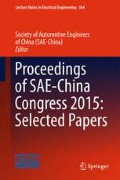Abstract
A finite element model for the control arm of an electric vehicle is established in Hypermesh software and a mode analysis is conducted by Optistruct solver. Modal testing is designed to prove correctness of the FE model. Strength analysis has been calculated by the method of inertia release under different working conditions in Optistruct solver. The load time history of control arm is extracted by using the theory of multi-body dynamics. Completing control arm fatigue life evaluation after fatigue simulation, which could provide guidance for fatigue experiment and optimization.
Access this chapter
Tax calculation will be finalised at checkout
Purchases are for personal use only
References
Automotive Engineering Manual Editing Committee (2001) Automobile engineering manual (The design paper). China Communications Press, Beijing
Qin D, Xie L (2013) Fatigue reliability design. Chemical Industry Press, Beijing
Yu K, Zhou C (2007) Mastering hypermesh. Science Publisher, Beijing
Xiao C, Zhou D, Wang Z et al (2011) The car door modal calculation and the analysis of combined optimization. J Chongqing Jiaotong Univ (3):465–469
Qi X, Wu Y, Peng W et al (2009) Car white body modal test method research. Automot Eng 8:39–43
Cheng K (2011) SUVs independent suspension simulation based on ADAMS. Wuhan University of Technology
Fu Y, Jin W, Qiao W (2009) Inertial release principle in the application of the frame structure optimization design. Mach Des Res (1):65–67
Wang Y, Wang C, Ma Z (2010) Based on ADAMS/Car ride simulation comfortability. Mach Des Manuf 4:81–82
Xie L, Lin W, Xu H et al (1993) Under complicated load conditions mean stress correction method. Acta Aeronautica et Astronautica Sinica (12):639–641
Author information
Authors and Affiliations
Corresponding author
Editor information
Editors and Affiliations
Rights and permissions
Copyright information
© 2016 Springer Science+Business Media Singapore
About this paper
Cite this paper
Zhu, M., Guo, J., Liu, T. (2016). Finite Element Analysis and Fatigue Analysis of Control Arm. In: Proceedings of SAE-China Congress 2015: Selected Papers. Lecture Notes in Electrical Engineering, vol 364. Springer, Singapore. https://doi.org/10.1007/978-981-287-978-3_41
Download citation
DOI: https://doi.org/10.1007/978-981-287-978-3_41
Published:
Publisher Name: Springer, Singapore
Print ISBN: 978-981-287-977-6
Online ISBN: 978-981-287-978-3
eBook Packages: EngineeringEngineering (R0)

